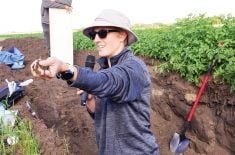NEWTON, Man. – Henry Dyck was helping sandbag a neighbour’s house when he uttered a thought that is common among farmers east of Portage la Prairie, Man.
“It’s pretty well a given that we won’t be able to harvest,” said Dyck, who grows nursery trees for the Jeffries Brothers company.
It was less than 24 hours before the dike at the Hoop and Holler Bend was breached May 14.
Potato grower Brian Smith said almost the same thing a few hours after the dike was breached and millions of litres of water began to pour into local farmland.
Read Also

Soybean market still figuring out implications of China-U.S. pact
Soybean futures had a muted reaction to the U.S. trade deal with China as the market tries to figure out the nuances of the deal.
“It’s 100 percent sure that we’ll lose our land here,” said Smith.
His family also has land along the Portage Diversion of the Assiniboine River, which channels excess water north to Lake Manitoba. The diversion is as full as possible and has spilled in a number of places.
It’s the reality Portage la Prairie farmers have come to accept since the provincial government said May 9 it was considering intentionally flooding land just southeast of Portage to prevent a likely much bigger breach further downstream. The government also announced it would push the diversion to its maximum level, and then some.
The breaching deadline was repeatedly delayed during the week as farmers and urban residents rushed to protect their properties and help neighbours who were directly in the planned flood’s path.
The immediate anxiety about losing houses received the lion’s share of attention after the announcement, but the economic reverberations will reach through Manitoba’s economy and shake the agriculture industry.
Portage is home to some of Manitoba’s highest-value agricultural operations with large amounts of potato, vegetable and nursery tree production.
It’s the kind of diversified and value-added agriculture that many rural communities dream about, and much of it is threatened by the flood waters. Hundreds of jobs are in jeopardy on vegetable and tree farms, and processing and handling plants are also affected.
Larry McIntosh, general manager of Peak of the Market vegetable cooperative, said much of its production comes from the region.
“A lot of our carrots are in that area,” said McIntosh, estimating 20 to 30 percent of the crop might be lost this year.
Peak is a big packager and a major provincial exporter. The area also produces a lot of Peak’s broccoli, asparagus, green onions and cooking onions.
“How long the water stays and whether (Peak farmers) get another planting this year are questions that are now being asked,” said McIntosh.
Keystone Agricultural Producers president Doug Chorney said many vegetable and nursery farmers grow expensive perennial crops that will probably be killed by this flood.
“It’s devastating for all those producers,” said Chorney. “It’s going to be a multi-year impact.”
Former KAP president and Portage area producer Ian Wishart said many people are going to have a bad year.
“When I drive around this area, I see a lot of jobs that are going to be lost.”
Many of the big vegetable and tree nursery farms offer off-farm jobs for grain farmers and their spouses, and that income can be crucial for many families.
Smith said farmers in the area are in a bind, even if their land is not flooded.
“We don’t know whether we’ll be able to get in with the equipment to work the field, because with the dikes possibly breaching at any time, we don’t know if it’s even safe to be planting in those areas,” said Smith.
Dyck said many of the trees on his farm might drown as the local water table rises. It will be too late to harvest the trees this spring once the land dries, and many may be too large to harvest in the fall.
The main cost won’t be to him, but to Jeffries Brothers, who contracts his production.
A few minutes later a Jeffries Brother trucked rolled up to the yard. Instead of trying to collect trees or equipment for its own needs, it brought a load of sandbags to help protect this rural home.
“We’re doing what we can,” said driver Roland Jeffries.















